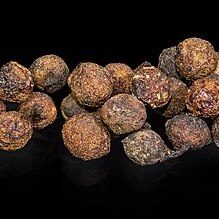Deciduous shrubs or trees, up to 12 m tall. Bark green or green-brown. Young branchlets green, brownish yellow or brown when dry, smooth. Winter buds ovate; stipe ca. 1 mm. Leaves alternate; petiole 10-12 mm; leaf blade greenish pale abaxially, dark green adaxially, ovate, broadly ovate, or narrowly ovate, 5-14 cm or less than 5 cm, 2.5-8 cm wide, papery, densely pubescent, later gradually glabrate abaxially, glabrous adaxially, trinerved or triplinerved, base rounded, sometimes broadly cuneate, apex acuminate. Umbels with 4 involucral bracts; peduncles ca. 4 mm, glabrous; involucral bracts ciliate, pubescent on base inside, 7-9 flowers included. Male flowers: tepals green before bloom, broadly elliptic or subrounded, glabrous, apex rounded, ca. 1 mm in outside whorl; filaments glabrous, 2-glandular at base in 3rd whorl; glands triangular-reniform, stipitate, sometimes 1 at filament in 1st and 2nd whorl; pistil exserted at center, less than 1 mm. Female flowers yellow; pedicels ca. 2 mm, pubescent; tepals broadly ovate, glabrous, apex rounded, ca. 1.5 mm in outer whorl, ca. 1.2 mm in inner whorl; reduced stamens fasciated, ca. 0.8 mm in 1st and 2nd whorls, 2-glandular at filament base in 3rd whorl; glands triangular or oblong, unequal in size, irregular long stipitate; ovary elliptic, glabrous. Fruits subglobose, 6-8 mm in diam.; stipes 4-7 mm. Fl. Apr, fr. Sep.
More
A shrub or tree. It grows 12 m tall. It loses its leaves during the year. The leaves are oval to oblong and 3-19 cm long by 2-12 cm wide. They have a long point. They have an aroma when crushed. There are a few yellow flowers in round heads. There are 4 papery bracts. The fruit are round and 6-8 mm across.


